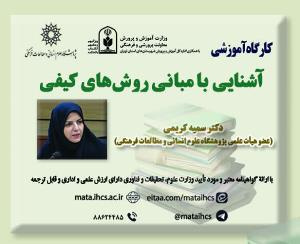معیارهای زیباشناختی آزاد بلگرامی در نقد بلاغی شعر فارسی (مقاله علمی وزارت علوم)
درجه علمی: نشریه علمی (وزارت علوم)
آرشیو
چکیده
یکی از پربارترین دوره های نقد ادبی در تاریخ ادبیات فارسی، دوره رواج شعر سبک هندی است. در این دوره به صورت مستقل رساله هایی در نقد ادبی نوشته شد. در بعضی از تذکره ها و رساله های بلاغت نیز نقد و نظرهای دقیق و علمی دیده می شود که هم از لحاظ کمیّت و هم کیفیّت نشان از اوج گیری نقد ادبی دارد. به خصوص در شبه قارّه هندوستان منتقدان عالم و صاحب نظری چون خان آرزو و آزاد بلگرامی آثار ارزشمندی در حوزه بلاغت و نقد ادبی خلق کردند. خان آرزو رساله های مستقلی در نقد ادبی نوشته است امّا نقدهای آزاد بلگرامی را باید در خلال تذکره هایش (به خصوص تذکره خزانه عامره ) و همچنین رساله بلاغتش ( غزلان الهند ) جست وجو کرد. آزاد بلگرامی از دریچه های مختلفی چون زبانشناسی، بلاغت، عروض و سبک شناسی به اشعار فارسی نگریسته و نظرات راهگشایی در این حوزه ها بیان کرده است. یکی از مهم ترین نظرگاه ها در نقدهای آزاد، نظرگاه بلاغت است. آزاد را باید به اعتبار رساله های اصیلش در حوزه بلاغت، غزلان الهند و سبحه المرجان ، یکی از مهم ترین بلاغیون قرن دوازده دانست. از این روی دقت های بلاغی او در نقد ادبی حائز اهمیّت ویژه ای است. در این مقاله نقدهای بلاغی آزاد جمع آوری و تشریح شده است سپس دیدگاه زیباشناسانه او از خلال نقدها استخراج و تحلیل و دسته بندی شده است. اکثر دقت های بلاغی آزاد معطوف به ایجاد تناسبات معنایی و گسترش شبکه تداعی و افزایش ارتباط میان واژه هاست. همچنین گریز از قید معهودات دنیای واقع و فاصله گرفتنِ تخیل ها و تصاویرِ شعر از محدوده قوانین طبیعت و معهودات ذهن از زمره معیارهای او در خلق زیبایی ادبی است. آزاد ملاک «کاربرد اهل زبان» را از مهم ترین معیارهای صحّت و سقم ساخت های زبانی ناآشنا و استعاره ها و تشبیه های غریب می داند و افزایش و گسترش وجوه شباهت را از ملاک های برتری تشبیه می شناسد. معیار زیبایی شعر در ذهن آزاد بر سه پایه اعجاب، تناسب و عینی گرایی استوار است.Azad Bilgrami’s Aesthetic Criteria; In the Rhetorical Critique of Persian Poetry
One of the most fruitful periods of literary criticism in the history of Persian literature is the era of Indian-style poetry, in which treatises were composed specifically on literary criticism. In some tazkiras and treatises on rhetoric, there are detailed scientific criticisms and opinions, which indicate the height of literary criticism in terms of quantity and quality. Especially in the Indian subcontinent, scholarly critics like Khan Arzu and Azad Bilgrami created valuable works in rhetoric and literary criticism. Khan Arzu authored independent treatises on literary criticism, but Bilgrami’s criticisms should be searched for in his tazkiras (especially Khizanah-i Amirah ) and rhetorical treatise ( Ghizlan ul-Hind) . Azad Bilgrami has looked at Persian poems from different perspectives such as linguistics, rhetoric, prosody, and stylistics and has expressed pioneering opinions in these areas. Azad should be considered one of the prominent rhetoricians of the eighteenth century due to his original treatises in the field of rhetoric, Ghizlan ul-Hind and Subhat al-Marjan . Therefore, his rhetorical approach to literary criticism is of particular importance. In this paper, Azad’s rhetorical criticisms have been collected and explained, then his aesthetic viewpoints have been extracted, analyzed, and categorized through the criticisms. Most of his rhetorical perspectives aim to create semantic congruence and correlations, expand the association network of words, and increase their connection. His criteria for literary beauty include escaping from the constraints of the real world and distancing imagination from the limits of nature laws and the conventions of the mind. Azad considers “applicability by native speakers” to be one of the essential criteria for the correctness of unfamiliar language constructions and strange metaphors and similes. He also considers the expansion of the aspects of similarity to be the criteria of the excellence of similes. The beauty of poetry in his opinion is based on the three pillars of aesthetic astonishment, congruence, and objectivity.







